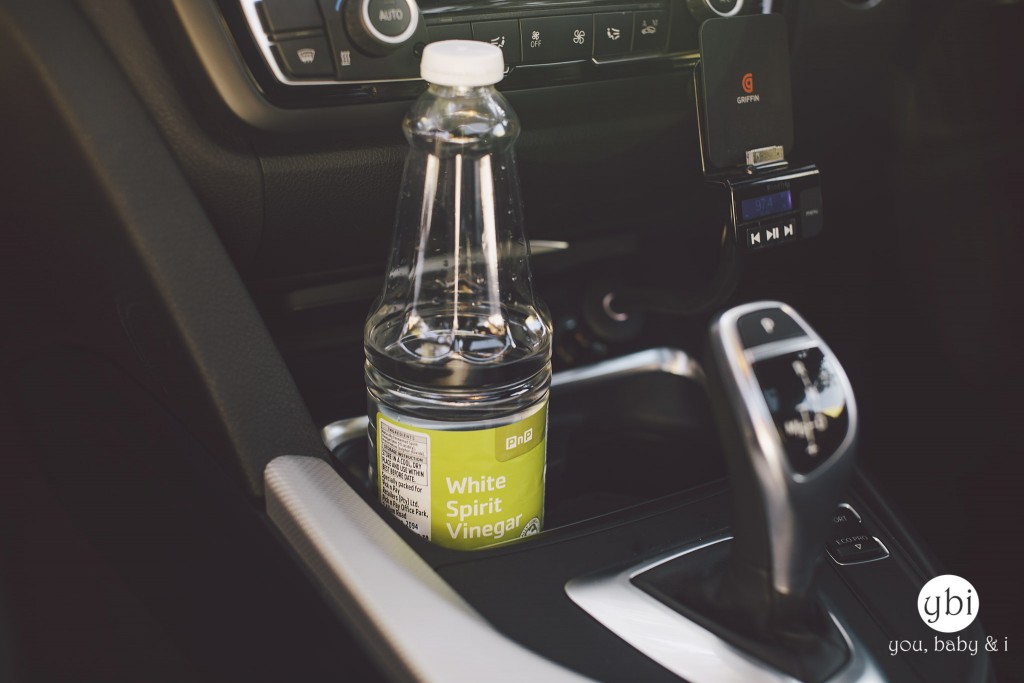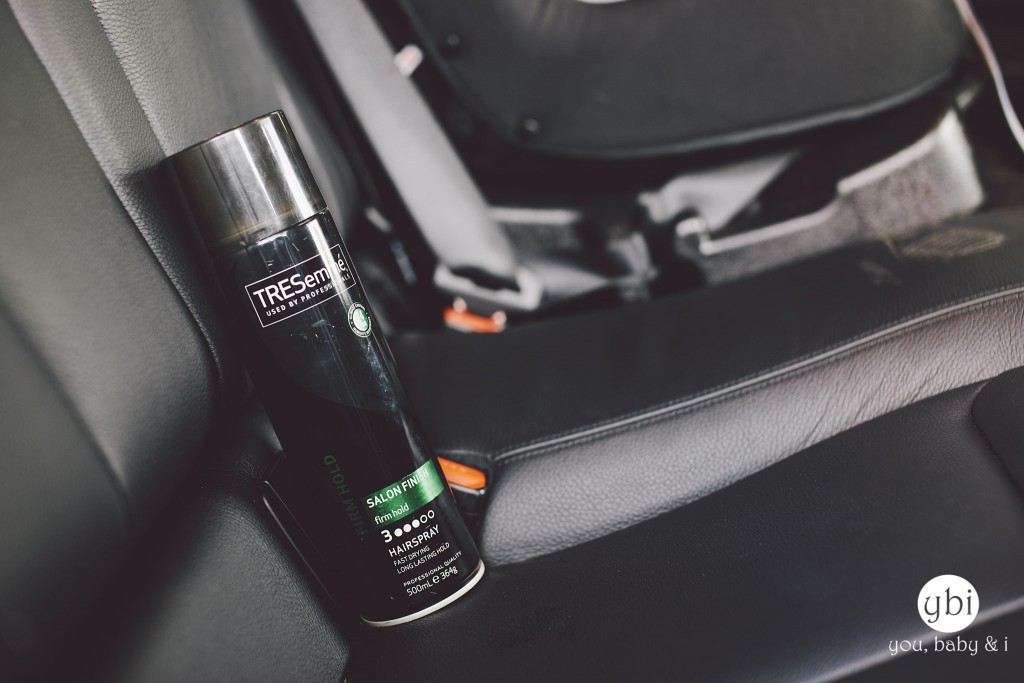6. Use Vinegar to Remove Stains
Stains on a car’s interior are not uncommon with kids, but thankfully, a bit of vinegar goes a long way in reducing the appearance of those stains. Place vinegar in a spray bottle and spray it thoroughly on the stained areas. Let it sit a few minutes before scrubbing the area with a soft bristled brush. If vinegar does not work, try some club soda. Soak up as much of the liquid as possible when you are finished to prevent it from smelling like mildew.
7. Club Soda for Vomit
When your kids get car sick, the smell is bad enough, but the stain lingers even longer. For this type of stain, pour some club soda on the area and blot it up. This not only removes the spot, but it neutralises the acid, which in turn, helps the smell. Keep pouring and blotting until the spot is completely removed. (Club soda – Carbonated water containing added dissolved salts, used especially as a mixer for drinks)
8. Use Hairspray for Ink
Hairspray is an effective ink remover. Just spray it on the spot, let it sit for several minutes and blot the ink. This may take several tries before the spot is completely gone. You can also cover the spot with salt to help in the removal process.
9. Dishwashing Soap or Starch for Blood Stains
Nobody likes to deal with blood, and hopefully you will never have to worry about cleaning it out of your car.
If you find yourself dealing with it, follow these steps to remedy the problem. First, blot the stain with a damp, cold rag as much as possible to remove the surface blood. Be careful not to rub as this can cause it to set in. Add a bit of dishwashing soap to a spray bottle of water and spray the spot carefully. Let the mixture sit for a few minutes and then start blotting the stain gently. Continue doing this until the stain is gone. Dry laundry starch also works well. Mix it with water until it forms a paste and apply it to the stain. Let it dry completely and loosen it with a bristled brush. Vacuum up the remainder!
10. Use Nail Polish for Scratches
It is likely that eventually you will find a scratch or two on your car. Just place a thin coat of clear nail polish over the scratch. This will prevent the exposed metal from rusting, which can really save your vehicle’s body over time.
Source for Mom hacks: http://www.gumtree.co.za/pages/autos/diy-maintenance/
Thank you Gumtree, these hacks are really going to help me during the holidays with 2 kids! I’ve learnt that maintaining a car isn’t difficult especially if the correct information is so easily accessible. While exploring the auto tips section on the website, I found important information to bookmark for future reference. Over the past few weeks I’ve learnt about mileage, car batteries and oil changes – information that I would have never looked up until I was stuck in a situation.
Gumtree is more than an advertisement platform, it’s now a website customised for your lifestyle!



35 comments
I do not yet have a car but I will be honest I just thought boo would take care of anything technical when it came to car maintenance. This is a great post and definitely need to check out Gumtree
These are really great tips! Sometimes we spend too much money on fancy products for cleaning our car, when in fact the small, cheaper, and simple items that we have at home can already help. Great post!
These are some awesome hacks!! I loved the one about using toothpaste to make foggy headlights clean. I will be trying that today!! It is needed!!
Love these tips! Especially that these are all items we already have! Perfect!
These are some really great tips. i love the one about hand sanitizer for iced locks!!!
Dry Ice will help pop dents out of cars? I am definitely going to have to try that one on mine and my Mom’s car!
These are great hacks! I am not super handy, but I could definitely manage these! Thanks for sharing!
Copper scrap recycling statistics Copper scrap prices today Scrap copper purity standards
Copper scrap trading platform Copper scrap commodity trading Copper scrap mold casting
Copper recycling legislation Copper scrap melting processes Copper scrap melting processes
Aluminium scrap pre-treatment Aluminium scrap pricing trends Aluminium scrap heat treatments
Metal recycling industry trends Ferrous metal reutilizing Iron salvage and recycling
Ferrous metal separation, Iron and steel recycling and reclamation, Scrap metal value extraction
Scrap metal recycling center Ferrous metal collaborations Iron reclamation yard services
Ferrous material reclamation, Iron scrap utilization and reclamation, Metal waste inventory control
Metal scrap sorting technology Aluminium scrap sustainable practices Aluminium scrap trading strategies
Metal recycling services, Environmentally friendly aluminum cable recycling, Metal industry trend analysis
Scrap metal brokering Ferrous material shearing Iron scrap recovery plant
Ferrous material recycling auditing, Iron scrap transportation services, Scrap metal sustainability standards
Metal export compliance Scrap aluminium shredding Aluminium recycling experts
Metal residue reprocessing, Aluminum cable scrap certifications, Environmental metal recycling
Scrap metal recovery plant Aluminium recycling ecosystem Scrap aluminium certification
Metal processing services, Aluminum cable scrap import restrictions, Scrap metal recovery facility
Scrap metal reclaiming plant Ferrous metal sorting Iron scrap yard services
Ferrous waste reclaiming and recycling, Iron scrap refining services, Metal scrap recycling solutions
Scrap yard operations Aluminium scrap innovation Aluminium recycling standards
Scrap economic trends, Scrap aluminum cable types, Scrap metal sales
Scrap metal disposal center Scrap aluminium value Aluminium recycling facility management
Metal waste disposal center, Efficient aluminum cable recycling methods, Scrap metal baling
Scrap metal reutilization services Ferrous metal recycling machinery Iron reclamation and recovery solutions
Ferrous material waste minimization, Iron scrap retrieval yard, Metal waste compacting
Scrap metal trade associations Safety measures for working with aluminum scrap Aluminium recycling precision
Scrap metal import restrictions, Aluminum cable recycling process, Scrap metal remodeling
Scrap metal appraisal Ferrous material recycling wildlife conservation Iron scrap resale
Ferrous material material flow analysis, Iron waste recovery plant, Metal reclaimer
Metal scraps recovery Aluminum scrap reclamation Scrap aluminum recycling process
Metal waste recovery services, Aluminum cable scrap reuse, Scrap metal reclaiming plant
Metal recovery and reprocessing Aluminium recycling value chain Scrap aluminium inventory
Scrap metal reclaim, Environmental impact of aluminum cable recycling, Metal scrap reclamation yard
Scrap metal recycling services Ferrous material recycling value Iron recycling management
Ferrous material recycling reliability, Iron scrap reclamation processing, Scrap metal transaction transparency
Copper scrap packaging Efficient copper scrap utilization Copper scrap shipping
Non-ferrous scrap metal, Scrap Copper wire stripping machine, Metal recycling and recovery center
Copper scrap transportation Copper is a soft, malleable, and ductile metal that has been used since ancient times for various purposes. It is an excellent conductor of electricity and heat, making it a critical component in many industries like electronics, construction, and transportation. The manufacturing process of copper begins with mining copper ore, which is commonly found in underground or open-pit mines. The ore is drilled, blasted, and then loaded onto trucks or conveyors for transport to the concentrator. At the concentrator, the ore is crushed and ground into a fine powder. The powder is then mixed with water and chemicals, such as flotation agents and sulfuric acid, to separate the copper minerals from other minerals and impurities. The resulting slurry is then pumped into flotation tanks, where the copper minerals attach to air bubbles and are separated from the unwanted material. The froth, containing the copper minerals, is skimmed off and collected, while the remaining waste material, called tailings, is sent to a special storage facility designed to prevent environmental contamination. The froth containing the copper minerals is dried and then sent to a furnace for smelting. Here, the copper minerals are heated to high temperatures in the presence of oxygen, which causes them to react and form copper metal. The molten copper is then poured into molds and cooled, forming copper ingots. These ingots can be further processed into various copper products according to the needs of the market. Some of the popular copper products include copper wire, tubing, sheets, and plates. In the final stage of the manufacturing process, the copper products are inspected, tested, and sometimes coated or treated to enhance their durability and corrosion resistance. In conclusion, the manufacturing process of copper involves several stages, including mining, crushing, grinding, flotation, smelting, and casting. The process is carefully controlled to ensure the purity and quality of the final product, which is essential for its numerous applications in various industries Scrap metal sustainability standards Copper scrap tracking Copper ingot scrap purchase Global Copper scrap market Copper scrap refining methods Robotics in metal recycling
Copper scrap industry insights Copper has been used by humans for thousands of years for its versatile properties and aesthetic appeal. In the modern era, copper has become increasingly popular in building and home decor primarily for its unique patina that changes over time. Copper has been used in various forms in architecture for centuries, from its use in ancient structures like the Parthenon in Greece to more modern buildings like the Chrysler Building in New York City. Copper has proven its durability and resistance to corrosion, making it an excellent choice for roofing, gutters, and downspouts. Copper can increase a building’s energy efficiency, as it is a good conductor of heat and can help regulate temperatures. Copper also has good sound-dampening properties, making it ideal for noise reduction in busy areas. In home decor, copper has gained popularity for its warm, metallic finish that adds a touch of glamor to any space. Copper home accessories like lamps, mirrors, and art pieces come in a wide variety of styles and add an elegant and sophisticated feel to any room. Copper cookware has also come back into fashion, as it is durable, conducts heat well, and gives any kitchen a classic look. One of the most appealing things about copper is the way it ages over time. As copper is exposed to air and moisture, it develops a patina that is unique to each piece. This natural aging process is highly sought after in both architecture and home decor. The patina ranges from a bright, shiny copper color to a rich, earthy brown or green. Many people find the natural patina to be beautiful and prefer not to polish or clean their copper pieces, so that they can enjoy the unique patina that develops over time. In conclusion, copper has a rich history in building and home decor. Its versatility and exceptional performance in various applications, combined with its beauty and aging process, make it a timeless material. Whether utilized in a large commercial building or a small home decor piece, copper can add a touch of elegance and style to any setting Scrap metal reutilization Industrial copper waste solutions Copper radiator recycling Copper scrap sorting and grading Copper scrap warehousing Metal waste exchange
Electronic waste recycling Metal waste disposal facility Iron scrap treatment
Ferrous material production scheduling, Iron waste processing center, Metal scrap sourcing
Copper scrap yards Copper scrap classification Metal waste disposal regulations
Copper cable types, Scrap metal price negotiation, Copper scrap industry networking
Metal reclamation and recycling yard, Copper scrap fabrication, Copper cable scrap resale, Scrap metal recovery services
Metal scraps collection Ferrous material recycling guidelines Iron recovery and reclaiming yard
Ferrous material recycling green initiatives, Iron waste collection points, Sustainable practices in metal recovery
Scrap metal recovery center Ferrous material emissions control Iron scrap reprocessing facility
Ferrous metal recycling yard, Iron scrap regeneration, Metal reclamation facility
Metal recycling recovery yard Ferrous material resource conservation Iron reclaimer
Ferrous metal recycling economics, Iron scrap processing center, Scrap metal recovery strategies
Metal recycling equipment Ferrous scrap reuse Iron salvage and reclamation
Ferrous material waste grading and sorting, Iron reprocessing center, Scrap metal reclamation processes